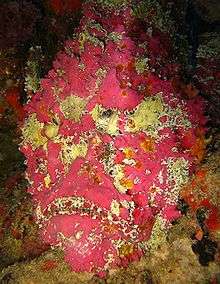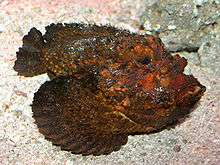Synanceia verrucosa
Synanceia verrucosa is a species of venomous fish in the family Synanceiidae, commonly known as the Reef Stonefish. The Reef Stonefish is the most widespread species of stonefish, mostly found in shallow waters of the Red Sea and the Indo-Pacific.[1] It is the deadliest fish in the sea, with incredibly effective venom.[2] Its venom can be lethal to humans.[3][4]
| Reef Stonefish | |
|---|---|
 | |
| Scientific classification | |
| Kingdom: | Animalia |
| Phylum: | Chordata |
| Class: | Actinopterygii |
| Order: | Scorpaeniformes |
| Family: | Synanceiidae |
| Genus: | Synanceia |
| Species: | S. verrucosa |
| Binomial name | |
| Synanceia verrucosa Bloch & J. G. Schneider, 1801 | |

This stonefish is usually brown or grey, and it may have areas of yellow, orange or red.[5] This species reaches up to 30–40 centimeters long; a specimen of 51 centimeters has been recorded.
Distribution and habitat
This stonefish lives primarily above the Tropic of Capricorn. It is the most widespread species in the stonefish family, and is known from shallow tropical marine waters in the western Pacific Ocean and the Indian Ocean, ranging from the Red Sea and coastal East Africa to French Polynesia and southern Japan.[3]
There is also evidence showing that S. verrucosa occurs in the far eastern Mediterranean Sea, either through release of aquarium specimens or Lessepsian migration via the Suez Canal. The first documented individual was an adult that was captured in 2010 near Yavne, Israel.[6]
This fish lives in coral reefs. It may settle on and around rocks and plants, or rest on the seabed.
_(6123739451).jpg)
The Reef Stonefish has evolved many adaptations to help them succeed in the reef bottom. Their skin is rocky and uneven, which helps them hide and remain camouflaged in between rocks and corals.[7][8] Among these adaptations are the 13 dorsal spines that protect the animal when necessary.
Feeding
The reef stonefish eats mostly small fish, shrimp and other crustaceans. It captures prey by sitting motionless on the reef floor and waiting for animals to swim by. The stonefish will then engulf its prey, doing so at incredible speeds. Some stonefish have been recorded striking their prey in .015 seconds.[9]
Human uses
The primary commercial significance of this stonefish is as an aquarium pet. It is also sold for meat in Hong Kong markets. It is consumed in the Philippines, especially in Chinese restaurants, and in Japan.
Toxicity

The reef stonefish is the most venomous fish in the world.[5] Its dorsal area is lined with 13 spines, each of which has two venom sacs.[5] The spines are sharp and stiff and have been known to pierce boot soles.[10] Stonefish venom can be fatal at a dose of only 18mg, which the fish is capable of releasing with only six of its thirteen spines. The protein makeup differs between the three species of stonefish, but in Reef stonefish the fatal protein is the verrucotoxin protein.[11]
Effects of the venom include severe pain, shock, paralysis, and tissue death.[10] A large dose can be fatal to humans, generally young children, the elderly, and those with weakened immune systems. Medical treatment includes the antivenom. A local anesthetic can reduce the pain. First aid includes immersion of the affected limb in hot water; this is thought to help denature the proteins in the venom. The immobilization of venom at penetration site using a tourniquet or firm constrictive bandaging is no longer recommended.[12] Surviving victims may have nerve damage, which can lead to local muscle atrophy.
The venom consists of a mixture of proteins, including the hemolytic stonustoxin, the proteinaceous verrucotoxin, and the cardiotoxic cardioleputin.
Reproduction
The Reef Stonefish lives most of its life as a solitary animal, and during mating season only aggregates with the opposite sex for a short time. When a female stonefish has reached sexual maturity, she will lay her unfertilized eggs on the floor of the reef. A male will then swim by and release sperm onto the layer of eggs, fertilizing them. Stonefish eggs are fairly large, with young fish hatching well developed. The mating system of the Reef Stonefish is promiscuity, as the female will not discriminate between which males can lay their sperm on the egg layer. Sexual dimorphism is apparent in reef stonefish, with females being larger than males.[13]
References
| Wikimedia Commons has media related to Synanceia verrucosa. |
| Wikispecies has information related to Synanceia verrucosa |
- Smith, J. L. B. (1977). Smiths' Sea Fishes. Springer Berlin Heidelberg. p. 478. ISBN 9783642828584.
- McGrouther, Mark. "Reef Stonefish, Synanceia verrucosa". The Australian Museum. Retrieved 2019-11-04.
- Capuli, E.E.; Ortañez, A.K. "Synanceia verrucosa, stonefish". Fishbase. Retrieved 30 June 2014.
- Wells, V. "The Stonefish – The Deadliest Fish in The World". Petplace. Retrieved 30 June 2014.
- McGrouther, M. (21 February 2013). "Reef Stonefish, Synanceia verrucosasasa (Bloch & Schneider, 1801)". Sydney: Australian Museum. Retrieved 30 June 2014.
- Edelist, D.; Spanier, E.; Golani, D. (June 2011). "Evidence for the cccurrence of the Indo-Pacific stonefish, Synanceia verrucosa (Actinopterygii: Scorpaeniformes: Synanceiidae), in the Mediterranean Sea". Acta Ichthyologica et Piscatoria. 41 (2): 129–131. doi:10.3750/AIP2011.41.2.09.
- "Adaptation". bioweb.uwlax.edu. Retrieved 2019-11-04.
- Smith, J. L. B. (1977). Smiths' Sea Fishes. Springer Berlin Heidelberg. p. 478. ISBN 9783642828584.
- "Nutrition". bioweb.uwlax.edu. Retrieved 2019-12-06.
- Taylor, G. (2000). "Toxic fish spine injury: lessons from 11 years experience" (PDF). South Pacific Underwater Medicine Society Journal. 30 (1): 7–8.
- Yazawa, K; Wang, J-W (August 2007). "Verrucotoxin, a stonefish venom, modulates calcium channel activity in guinea-pig ventricular myocytes". British Journal of Pharmacology. 151 (8): 1198–1203. doi:10.1038/sj.bjp.0707340. PMC 2189832. PMID 17572694.
- White, J. (2001). "First Aid for Marine Bites and Stings". CSL Antivenom Handbook. www.toxinology.com. Retrieved 30 June 2014.
- Fewings, D.G.; Squire, L.C. (April 1999). "Notes on reproduction in the estuarine stonefish Synanceia horrida" (PDF). SPC Live Reef Fish Information Bulletin.
External links
- Synanceia verrucosa. Integrated Taxonomic Information System.
- Photos of Synanceia verrucosa on Sealife Collection